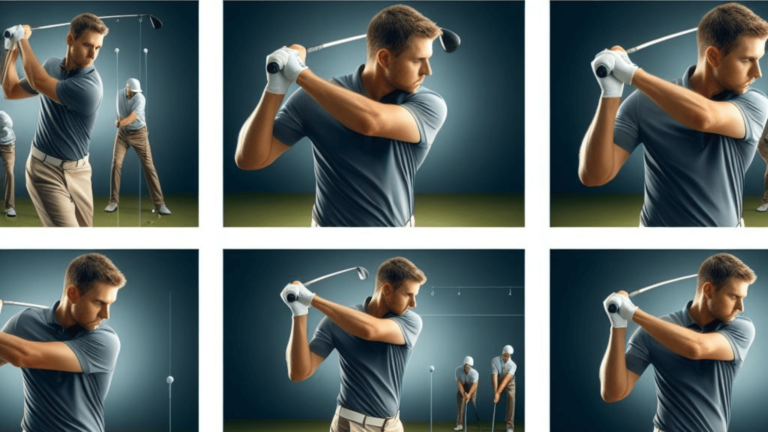How to Make Divots in Golf
Golf can be a frustrating but rewarding sport for both new and experienced players. Making solid divots after contact with the ball is an aspect of the golf swing that is frequently overlooked but plays an important role in ball striking. Learning how to make proper divots can significantly improve your golf swing, ball striking, and consistency. In this article, we will look at several ways that any golfer can practice consistently taking nice divots on their golf shots with every club in their bag.
For those new to golf, a “divot” is a chunk of grass and dirt that flies out of the ground after making solid contact with the golf ball at impact. Divots indicate that the club is hitting down aggressively on the ball, allowing for maximum compression and efficient energy transfer from club head to ball. While large divots that appear to be “scooping” the ground are not always desirable, smaller divots demonstrate solid downward contact. Players who hit the ground too early or take “fat” shots will either leave no divots or ragged edges from only barely clipping the grass after impact.
Good divots indicate an efficient swing plane at impact, proper weight shift, and clean ball striking. If you aren’t consistently taking divots, there are probably inefficiencies in your golf swing that are preventing you from hitting the ball at a proper downward angle of attack. Failure to compress shots correctly results in a loss of distance and accuracy. The remainder of this article delves into various swing adjustments, both at address and during motion, that promote proper divot taking for all clubs in the bag to maximize performance.
Proper Set Up and Ball Position for Divots
The setup and address position are critical for effectively making divots during the swing motion. Without proper posture, weight distribution, spine angle, and ball position for each club, many golfers struggle to make solid downward blows on the ball at impact. Let us take a closer look:
Posture and Weight Distribution.
Maintain a slight athletic flex in your hips to allow the spine to naturally coil back and through. Maintain a straight spine while avoiding excessive rigidity. Distribute the body weight evenly between the balls of the feet. Too much weight on the toes or heels reduces rotational movement.
Spine Angle
The spine angle should be a comfortable tilt from the hips, with the shoulders hanging at address. Do not sway or reach too far at the address. This helps to naturally lower the arms/club into a good impact position.
Ball Position
Ball position varies depending on the club, with longer clubs striking slightly further forward in the stance than shorter ones, so pay attention to proper setup. The ball begins just inside the lead heel for the driver and moves back about 3 inches for each shorter club. Shorter irons and wedges place the ball near the center of the stance, allowing for a steeper downward attack.
Grip Pressure and Style
Proper but not overly tight grip pressure allows the club to naturally hinge and release without being too restrictive. Light grip pressure is essential. Pay attention to grip style, as strong grips make divot taking difficult, whereas neutral grips make it easier.
Swing Changes Promote Divot Making Contact
Now that the address position has been covered, the actual swing motion is critical to striking down aggressively through impact and taking good divots. There are a few key adjustments on the backswing and downswing/impact that aid in divot taking:
Maintain Spine Angle and Posture.
On the backswing, maintain the original spine angle and posture from address. Allow no straightening or swaying of the hips or upper body. This allows for a proper drop into impact position later.
Weight Transfer to the Trail Foot
On the backswing, feel about 70% of the weight load on the inner portion of the trail foot. This coil improves unwinding through impact for divots.
Dropping into Slot.
Starting the downswing by shifting weight laterally over the lead leg and “dropping” the arms/club into the slot maximizes the angle of attack for divots. Don’t sway laterally or spin your upper body open too soon.
Compress Downwards with the Lead Side
Feel the lead knee, quad, and hip firmly driving into the ground on the downswing, allowing the body to clear out of the way as it approaches impact. Sources power and a downward strike.
Accelerate Club Through Impact
Do not slow down! Whip the club through impact, fully releasing the lead arm and club face. The wrist hinge accelerates, providing more downward strike energy.
Follow Through to Target
Hold the finish with the chest rotated open to the target and the majority of the weight on the lead foot. This ensures that the divot is properly formed AFTER the ball has been removed. Fat shots strike the ground before the ball.
Chipping and Pitching Divots.
In golf, you don’t just want to make divots during your full swing. It is also ideal for hitting shorter pitch and chip shots around the greens, though the swing adjustments vary slightly. The following are the keys to taking good divots on those touch shots:
Ball Position
To facilitate a steep angle of attack, the ball begins just inside the lead foot when chipping or pitching. The weight favors the lead side.
Narrow Stance
Keep your feet close together for stability, but don’t widen your stance too much, as this will inhibit spin and downward blow.
Hands Leads Clubhead
Allow the lead hand and clubface to release in front of the clubhead upon impact, adding loft and strike. Don’t flip your wrists too early.
Accelerate downward
Do not slow down! Maintain your speed while accelerating downwards through impact to ensure the best contact.
Land Lead Foot First
On the follow through, the lead foot should plant first, and then the body rotates towards the target. Never sway laterally or fall backward.
Practice Drills for Divots
Implementing some basic practice drills that focus on taking divots is extremely beneficial for committing the proper feel and technique to memory. Here are a few to consider:
Impact Bag Drill
Hit down hard on an impact bag, leaving divots and noticing sound/feel differences between flush and fat. Grooves should grab a bag.
Ball First, Ground Second.
Place two balls close together and attempt to hit the first ball without touching the second ball on the ground. Ensures divot occurs after impact.
Quarter Swing Divots.
Take 1/4 swings with short irons, concentrating on taking divots and brushing the grass after hitting the ball. Ingrain impact sensations.
Accelerate Through Impact
Make practice swings to take divots by aggressively increasing the club handle speed as the club approaches the ground. Maintain your speed.
Check your Divots!
Simply pay closer attention to the divots you take (or don’t take) on the driving range and course. Take note of any shallow or inconsistent areas and make necessary adjustments.
Proper Fitting Equipment for Divots
While swing technique is most important when taking divots, having properly fitted golf equipment can also help, depending on your needs. Here are some appropriate considerations.
Clubhead Design
Some iron/wedge clubhead designs have more bounce and cambered soles that work better for divots than others, depending on the swing.
Shaft Flex
Matching the proper golf shaft flex to your swing speed improves your ability to compress the ball properly through impact, resulting in good divots.
Shaft Weight
Choosing a total club weight that matches your personal preference and strength level allows you to take divots without feeling too heavy or too light.
Lie Angle
A properly fitted lie angle allows you to strike down more efficiently without having to manipulate the club while swinging. Get this checked!
Grip Style and Size
Using a grip size that matches your hands and experimenting with different grip styles can provide the right feel for taking divots without restricting your motion.
Conclusion
Learning to properly take divots in golf is one of the most significant “aha” moments for many players, as it demonstrates the ability to compress the golf ball correctly with efficient strikes for better shots. All golfers can improve their consistent divot taking for lower scores by addressing proper fundamentals in set up position, making key swing moves through impact, implementing focused practice drills, and using properly fitted equipment. Apply the advice given above, and you’ll be taking great divots and hitting better golf shots in no time.







